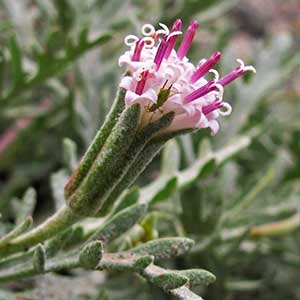Chaenactis thompsonii
Chaenactis carphoclinia
Thompson's pincushion
pebble pincushion, straw-bed pincushion
mostly 5–15+, ascending to erect.
mostly cauline, 2–5 cm;
largest blades ± elliptic, ± plane, 1-pinnately lobed;
lobes mostly 2–5 pairs, remote, ± plane.
basal (often withering) and, usually, cauline, 1–6(–10) cm;
largest blades ± 3-dimensional, not to somewhat succulent;
primary lobes mostly 2–7(–10) pairs, ultimate lobes ± crowded to remote, antrorse, linear, terete.
ascending to erect, 2–5 cm.
2–6 cm.
± obconic.
obconic to ± cylindric or hemispheric, mostly 5–10 mm diam.
paleae (0–)3–10+ (persistent, ± phyllary-like, apices visible among mature floret buds).
7–9 mm.
4–6 mm.
longest (10–)12–15 mm;
outer closely lanuginose, not stipitate-glandular, apices erect, ± rigid.
longest 7–10 mm, ± granular-glandular and villous;
apices (all or inner) erect to incurved, usually reddish, acuminate, aristate, terete.
mostly 1–3 per stem.
7–9 mm (eglandular);
pappi: longest scales 3.5–5 mm.
± terete, 3–4.5 mm;
pappi usually of 4(–5) scales, longest 3–5 mm.
Chaenactis thompsonii
Chaenactis carphoclinia
Of conservation concern.
Chaenactis thompsonii appears to be sister to C. evermannii; it is known from the mountains of central and northwestern Washington. The similar habits of C. thompsonii and C. ramosa (= C. douglasii var. douglasii) appear to result from convergent evolution in the distinctive habitat of their type localities (Wenatchee Mountains), not from a close genetic relationship as suggested by Cronquist.
(Discussion copyrighted by Flora of North America; reprinted with permission.)
Varieties 2 (2 in the flora).
Though occasionally suspected (P. Stockwell 1940), there are no confirmed natural or artificial hybrids between Chaenactis carphoclinia and any other member of the genus. The presence of paleae on the receptacle of C. carphoclinia is unique in Chaenactis.
(Discussion copyrighted by Flora of North America; reprinted with permission.)
1. Leaves basal and cauline, longest 1–6(–7) cm; petioles scarcely dilated proximally, ± herbaceous | var. carphoclinia |
1. Leaves ± basal, longest 7–10 cm; petioles dilated proximally, ± indurate | var. peirsonii |


